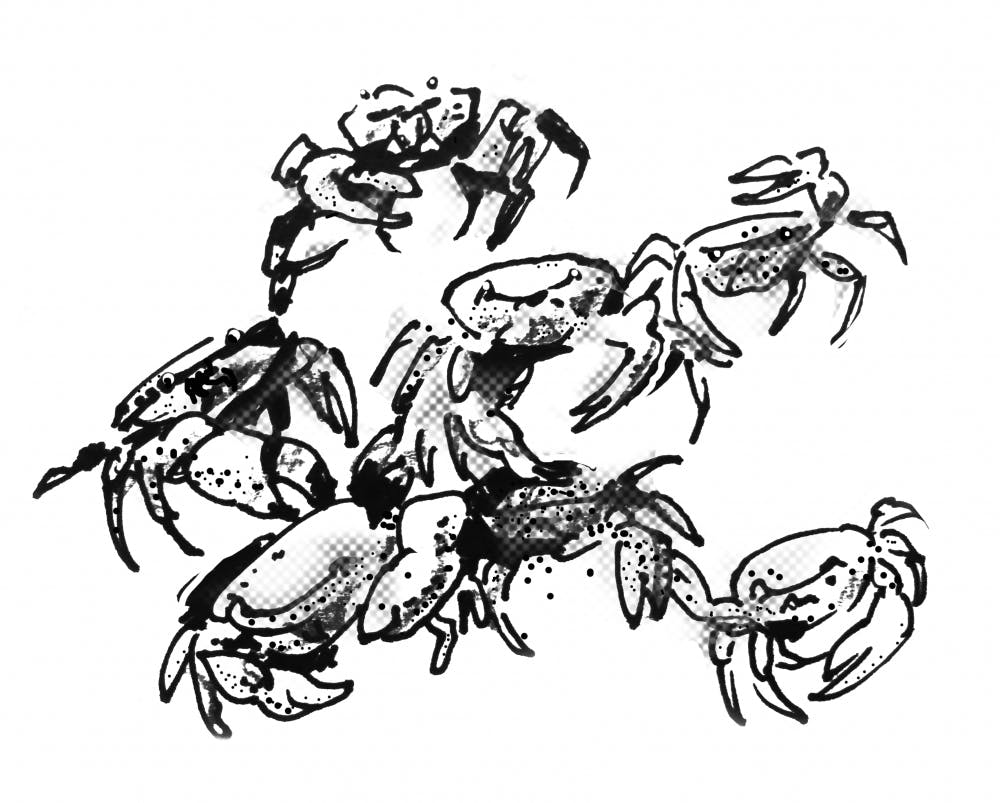The salt marshes of New England are disappearing. There is not one singular cause to which blame can be directed, however. As a recent paper has shown, it is the synergistic relationship between two factors — the dearth of purple marsh crab predators and the rising sea level resulting from climate change — that is responsible for this loss of salt marsh.
The crabs in question are sesarma reticulatum, or the purple marsh crab, which is an invasive species of crab that has lived in the salt marshes of New England for decades. Mark Bertness, co-lead author of the paper and professor of biology, describes them as “hippie crabs” due to the communal system of tunnels in which they live and breed. They feast upon the vegetation in the salt marshes — the various roots, rhizomes and so forth — but are usually kept in balance by the predators, namely the different types of fish that live in that area. But as the number of these predators declines due to human interaction, these crabs have been able to expand their numbers exponentially. According to the paper, the combination of the crabs’ ability to proliferate due to the low predatation and rising sea levels combine to affect the salt marshes more than if either factor acted alone.
To test this, the researchers went to the marshes of Colt State Park in Bristol, Bertness said. They dug up parts of the marsh and completely submerged them to mimic drowning. They did this in the winter so that the plants were not affected. Returning after winter, the researchers set the samples of marsh at different heights to simulate the effects of climate change-induced sea level rise. They also dug up hard peat from the same area for comparison.
Marsh at the high water level, through which the crabs did not traditionally tunnel due to the normally hard peat, all of the vegetation was eaten by the crabs, Bertness said, showing the effects of climate change combined with the effects of the salt marsh crabs spreading. When salt marsh peat is softened, crabs are likely to extend further and have a greater impact, said Sinéad Crotty ’15, another co-lead author of the paper and a graduate student at the University of Florida. Taking into account only climate change, eight percent of salt marshes will be lost; but considering this synergistic interaction of the two stressors, 86 percent will be lost, Bertness said.
Experiments in the last decade spurred the researchers to investigate the crabs’ effects. To see how the crabs fare in areas of low predation, they attached the crabs to fishing lines and left them in areas that have and have not experienced large human impact. In the areas of low human impact, they found that almost all the crabs were eaten in one night; but this was not the case in areas of high human impact, Bertness said. After three months, these crabs were still thriving.
Another past experiment involved total predator removal, where Bertness and other researchers cut off predators’ access to the crabs. While he had initially assumed that the experiment would have taken a couple of summers, after only one, there was a 50 percent reduction in the amount of biomass in the marshes.
In the latest experiment, Crotty was surprised by how quickly the proliferation of the crabs occurred. In the area studied, the crabs were grazing at the furthest points that they were known to graze within the first month. This suggests that the crabs are actively venturing from their burrows and looking for new areas to inhabit, and that as soon as these new areas were ready, they would, Crotty said.
Christine Angelini, another co-lead author of the paper and an assistant professor at the University of Florida, found the extent of the crabs’ impact to be surprising. Whereas she had initially assumed the area to which the crabs would tunnel would be more concentrated, she found in the study that the crabs could travel long distances to seek out new habitats. While the marshes had initially been slowly softened and eroded from the outside, they were now being eroded in softened patches throughout the marsh, leading them to have what Angelini described as a “swiss cheese” appearance. She had not expected the crabs to migrate in such an aggressive manner.
More synergistic studies such as this one are needed to study different parts of ecology, including the connection between predation and crab spread, said Jon Witman, professor of biology. He suggested more studies monitoring the rates of fish predation on the crabs in order to pinpoint which species in particular is responsible.
Efforts to figure out means to control the spread of the crabs other than the top predators is important in helping to mitigate the damage done by these crabs, Witman said. Moves to increase the local predator populations in these areas and reduction of fishing pressures are important in this regard, Angelini said.
People do not adequately appreciate what these marshes do in terms of ecosystem services, Bertness said. These include cleaning the water column and buffering the shoreline from storms. “If you monetize what shorelines do for us, mangroves and salt marshes are, in terms of ecosystem services, the most valuable systems on the planet on a hectare-by-hectare basis,” Bertness said. According to his calculations, there will be a $161 million a year loss in ecosystem services by 2050.





